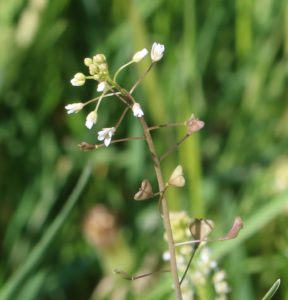Shepherd’s Purse: a Scrappy Survivor with a Deadly Secret
 This unassuming little plant taught me
This unassuming little plant taught me two three! things today!
Shepherd’s Purse (Capsella bursa-pastoris) is a non-native from Europe that can be seen popping up along the edges of streets and sidewalks in grassy areas that haven’t been mowed in a while. It is a ruderal (my new word!) species, meaning it is well adapted to disturbed areas, of which humanity leaves a trail wherever we go.
Shepherd’s Purse, like the similar-in-appearance Field Pennycress, is a member of the Brassica, or cabbage (also mustard and cruciferous) family. It’s tiny flowers are fairly nondescript, but it can be recognized by its obcordate (second new word! meaning a reverse heart shape, attached to the stem at the pointy end instead of the roundy end) seedpods that supposedly resemble the purse of a shepherd from days of yore.
The second third bit of knowledge imparted is that of “protocarnivory” in plants. Most people are familiar with carnivorous plants like pitcher plants, sundews and Venus’ flytraps, which snare or snatch insects that wander into their traps. Other plants exhibit a more insidious method of capturing and utilizing invertebrates for their own purposes.
The seeds of Shepherd’s Purse, for example, have been found to lure nematodes (minuscule roundworms found in soil) with tasty mucilage on their seeds; when the nematodes feed, they are killed by toxins and their tiny carcasses enrich the soil in which the seeds will germinate.
Who could have imagined what secrets lurked in the lives of these weedy little plants alongside the trail?
Originally published in Sycamore Greenway Friends.


